Winter Audio Reference: On-Board, Consumer, and Pro Solutions
by Derek Wilson on February 3, 2005 12:05 AM EST- Posted in
- Smartphones
- Mobile
The Cards
These are the first cards that we'll be taking a look at in their categories. Other sound hardware reviews that we do will have a point of reference to this article. For onboard solutions, we'll compare against the Realtek HD audio that we're reviewing today. When we look at consumer level add-in cards, the obvious metric is the Sound Blaster Audigy 2. For professional cards, we've chosen the Echo Audio Gina3g as our point of reference for its mix of features and solid quality.
The Intel, Gina3G, and Creative mix touches on high quality, integrated, multitrack/music recording, gaming, and the consumer audio solutions. We wanted to hit all these groups in this review in order to get a feel for what each had to offer. The first solution that we'll look at is the Intel solution.
Realtek Intel HD Audio
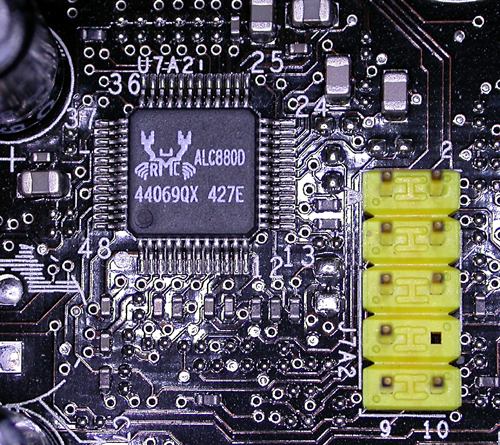
This is the Realtek Intel HD Audio codec chip.
As we can see, the Intel solution is the Realtek solution. We wanted to track down the DACs and opamps that drive the output, but finding these tiny chips on a motherboard proved too difficult a task for us. Suffice it to say that layout is key when dealing with an onboard solution. We actually plugged our Audigy in a PCI port further away from the video card, thinking we'd get better signal quality and noticed an 8dB increase in noise due to this:

This is a 1.5A low dropout positive regulator near the 3rd PCI slot on the 925XE board.
Imagine the difficulty in guarding against noise with an onboard solution if simply moving to a different PCI slot can change so much. Vendors other than Realtek are planning on coming out with HD audio compatible onboard solutions, and we are looking forward to testing those as well.
On the downside, the Realtek only has 20 bit stereo inputs, so doing a 24bit loopback is a little less than honest. The record quality of this onboard solution is less than optimal, and in very loud playback, a little noise can be heard.
Echo Audio Gina3G
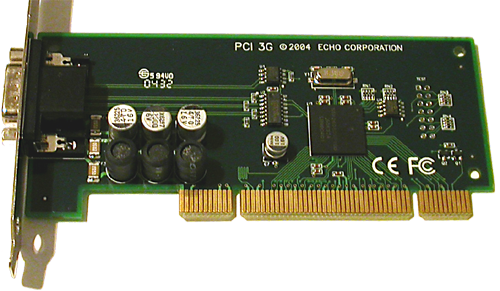
The Gina3G PCI card
The Gina3g is an entry level professional sound card from Echo Audio. Musicians on a budget are always on the lookout for a device that combines a few high quality analog inputs with a couple of coax and optical digital connections that support S/PDIF and ADAT I/O.
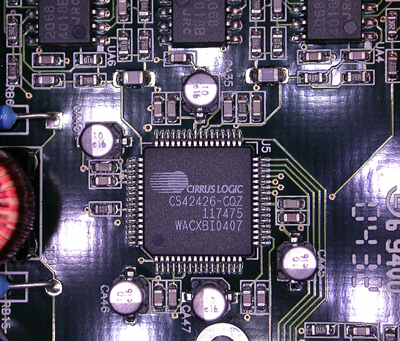
Inside the Gina3G breakout Box
This device would be a stop off on the way to something like the Lynx TwoB, or a DigiDesign ProTools solution. With the ability to record 8 digital channels at a time, 6 (highly configurable, balanced) analog outputs, and 2 universal analog inputs (accepts ¼ inch and XLR, balanced or unbalanced, and can provide 48v of phantom power), the Gina3g is targeted squarely at the end user looking to take their audio and put it on the PC. A small home studio could go the way of having a couple of rack mount devices - compressors, eqs, and an A/D - to bundle it all up and send it to the PC. The Gina would fit in nicely. There are both cheaper and more expensive solutions out there.
In any case, the reason why we are testing the Gina3g today is because its older siblings have done very well traditionally in terms of analog signal quality. We wanted to find out if Echo Audio's latest in the series still stacks up.
Creative SoundBlaster Audigy 2 ZS Platinum Pro
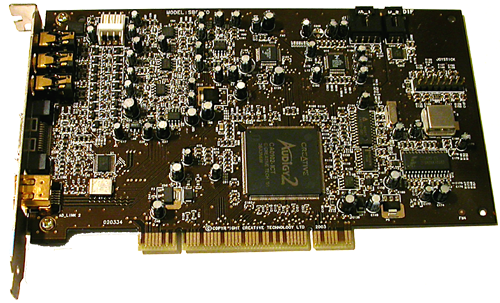
SoundBlaster Audigy 2 ZS Platinum Pro PCI Card
The Audigy is the consumer standard in sound hardware today. It is a very gamer and entertainment PC oriented solution. The Platinum Pro is a Swiss army knife of a sound card - a little of everything, but never exactly what you want. Digital playback is quality, but analog at 16-bit/44.1 kHz leaves something to be desired. Recording quality is solid, but there could be more I/O on the device if it is going to fit into any aggressive user's workflow. Lacking balanced analog I/O is a large oversight if Creative wanted to target the prosumer/audiophile. But in the end, the audigy does fit into just about every niche in which you could want a sound card. And it offers EAX Advanced HD as only Creative cards can.
Creative SoundBlaster Audigy 4 Pro
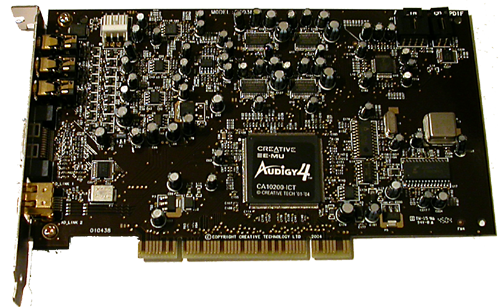
SoundBlaster Audigy 4 Pro
The SoundBlaster Audigy 4 Pro is basically an upgraded and massaged version of the Audigy 2 ZS Platinum Pro. The differences are in the quality of the DACs and ADCs used, some layout changes, and just a bit of a polish that makes the quality of the card fit the feature set better. Still offering the same gaming quality, the analog output of the card is now on par with professional level cards in some respects.
Summarizing the Differences
So, what are the key factors that are different among the contenders? Let's take a look:
-- DAC quality: the Audigy 4 has the highest quality DACs, though the Gina3G places it's DACs outside the PC in its breakout box. Here are the DACs used on the Audigy and Gina3G:
Audigy 2 DAC: 1x CS4382: 8out 114dB dynamic range, -100dB THD+N
Audigy 4 DAC: 4x CS4398: 2out 120dB dynamic range, -107dB THD+N
Gina3G DAC: 1x CS42426: 2in/6out 114dB dynamic range, -100dB THD+N
Both Audigy products use 4558c opamps with THD < .008%
Gina3G uses NJM2068 opamps with THD < .001%
-- Input quality: The Gina3G uses balanced I/O, and has the most input options. The quality of the ADCs on the Gina3G and Audigy are similar (Audigy is noisier with less THD). The Intel Audio solution only supports recording at a max of 20-bit/96kHz analog, and is noisy on recording. No pro digital recording features are enabled on the onboard solution even when lightpipe is present, so Creative and Echo have the Intel beat in digital recording as well.
-- Gaming features: The Creative solutions offer EAX 4.0 Advanced HD, which neither of the other cards can claim. Intel is able to include EAX 2.0 support along side it's DS3D and A3D support, but the Gina3G offers zero 3D hardware support or reverb API support. Included on the Gina3G is a DSP that is capable of such operations (Xilinx Spartan), but it's obviously intended for professional applications.
Other than that, the differences are in feature set and drivers. The Audigy cards offer the most in terms of "stuff" with their cards, though the Intel solution does a good job of filling in the gaps as well. Even though the Gina3G "only" supports 6-channel out on the consumer side, the fact that all 6 outputs are balanced TRS ¼ inch is a nice bonus for the musician. Depending on implementation, the Realtek solution can have optical and coax output, but Audigy and Gina3G both offer optical and coax in and out.










89 Comments
View All Comments
REMF - Thursday, February 3, 2005 - link
i would like to see how the Via envy24 cards stack up against the newer Realtek 880 and C-media HD chips, as well as against CL gear.bbomb - Thursday, February 3, 2005 - link
Please read his remarks before you go off crying that this round up sucks and you didnt do this card or that card. Read some of the comments in the commetns section and Dereks response before you spew out the same crap someone else has.He stated 6 posts above you soupy that these were done to creat a refrence point for each segment for future reviews of sound cards.
Perhaps you should remove the roundup part of the article title Derek.
ElFenix - Thursday, February 3, 2005 - link
i'll stick with the santa cruz for a while longer, i guess.Damien - Thursday, February 3, 2005 - link
I was surprised to not see the nForce 4 compared, given that it is one of the newest onboard sound components to support the latest gravy.Damien
soupy - Thursday, February 3, 2005 - link
no EMU cards? (0404, 1212). Those are some really hi-fidelity cards this review should've included. And yeah, there really has to be a good, solid sound system for reviews like these to be based on. All in all, this roundup was pretty bad.ProviaFan - Thursday, February 3, 2005 - link
#15 - Aardvark is dead. Sadly, because they made some good stuff, but they're not around any more, which means no driver updates, etc. :(For pro cards, you could try the MOTU 828mkII (maybe throw in a 24I/O or HD192 on the high end if you're going to cover that segment), the Presonus Firepod, and whatever Digidesign sells in that price range (comments on the Protools software would be required also if you're going to do that ;). If you wanted to go really high end, you could look at some Apogee D/A and A/D's... :D
Jigglybootch - Thursday, February 3, 2005 - link
I'm surprised there was no E-mu 0404 reviewed. It goes for about the same price point as a plain Audigy 2 ZS, but blows it away in every category.Also surprised by no Revolution 7.1/5.1 review.
segagenesis - Thursday, February 3, 2005 - link
#19 - I second that. However, I have not seen (or rather havent looked hard enough?) something since the soundstorm that does realtime AC3 out. And yes, please include at *least* the Revolution 7.1 in a future review. Maybe you should thrown in your stock AC97 on most boards you see now (Realtek 6 channel, not Intel HD Audio) just to show the difference between them and a $100+ card.I also fail to see the real benefit of Creative cards and hardware 3D audio when to me its always sounded like the game is in a cave or some other overdone (or underdone!) effect. Ok maybe you get a few extra fps but I have always played games using Miles Fast 2D/3D audio without complaint.
YMMV
mcveigh - Thursday, February 3, 2005 - link
you really should have had something with the via envy 24 chipset in there. there are so many boards out with one of those variants. personally I would have liked to see M-audio (or who ever they are now) revo 7.1 AND 5.1 as the new 5.1 is supposed to have better DAC's I've heard.EddNog - Thursday, February 3, 2005 - link
Mr. Wilson, please don't forget to mention the importance of bypassing the Kmixer resample stage. ;-)With even a merely decent system, the difference is obvious.
-Ed